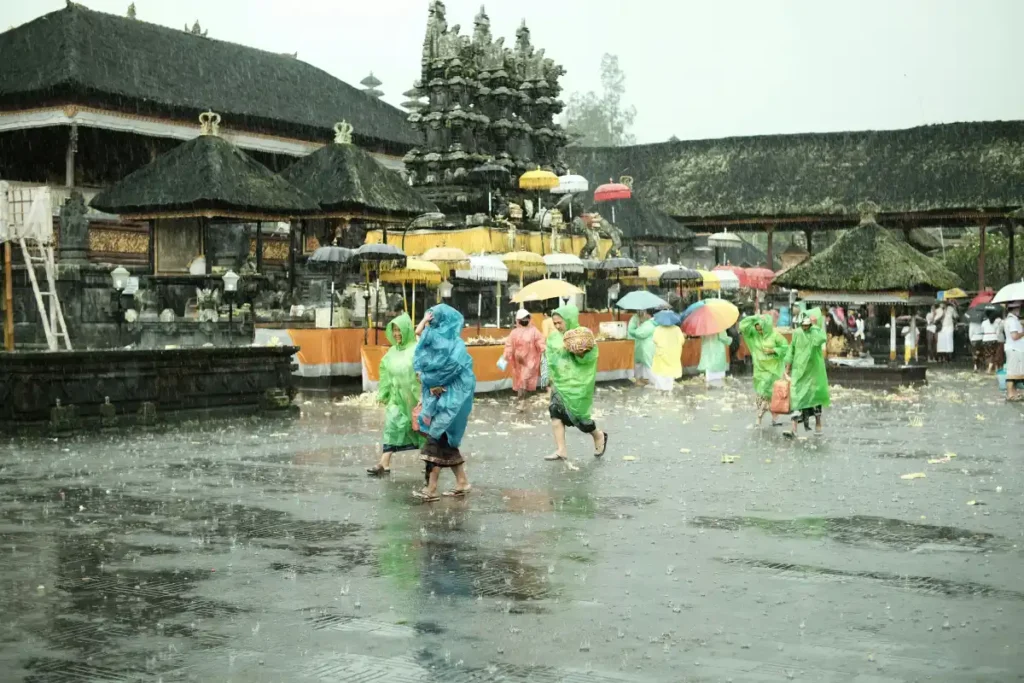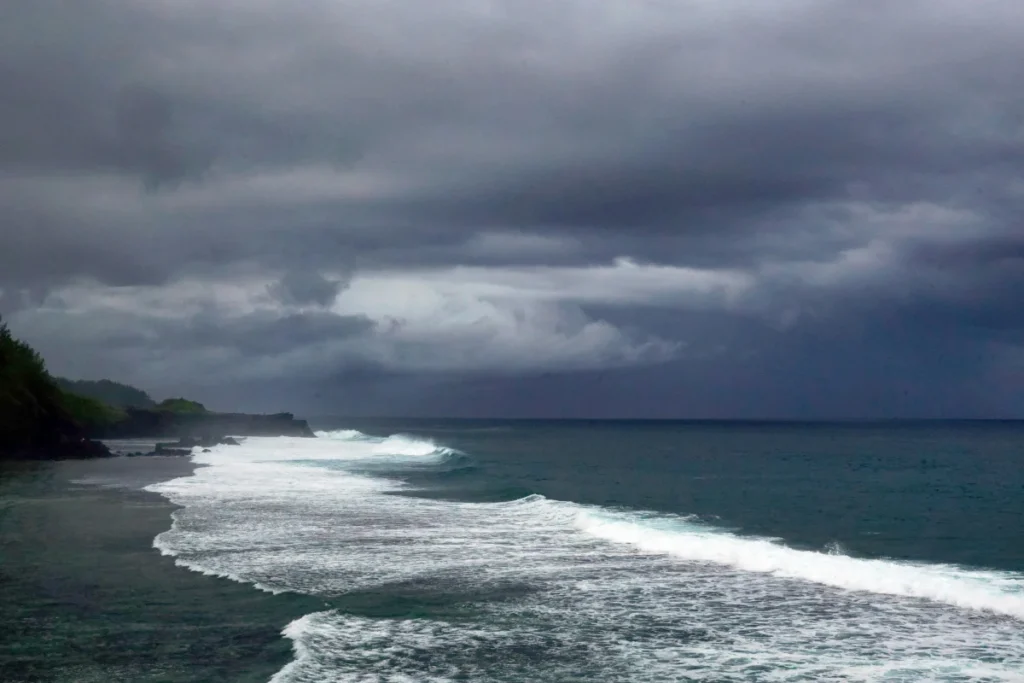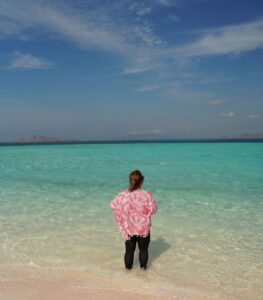
Planning your Bali adventure and wondering when the rain will finally stop? You are not alone. With its tropical climate, Bali experiences a distinct rainy season, but changing weather patterns in recent years have made things a bit more unpredictable. This guide will walk you through when the rainy season usually ends, how to check accurate forecasts, and what to expect if you’re visiting during this time, including the best places to stay and rainy day activities you will actually enjoy.
Table of Contents
ToggleUnderstanding Bali’s Seasons (and Why the Rain Doesn’t Always Follow the Rules)
Bali has two main seasons: the dry season and the rainy season. While this pattern still guides the overall climate, recent years have shown that the weather isn’t always as predictable as it used to be.
Dry Season (April to October)
This is typically the best time to visit Bali for consistent sunshine and outdoor activities. Days are warm and relatively dry, with lower humidity and cooler evenings. It’s ideal for beach trips, mountain hikes, diving, and exploring without weather interruptions.
Rainy Season (November to March)
During the rainy season, you can expect more frequent rainfall, especially from December to January, when showers are at their peak. However, it doesn’t usually rain all day. Most rainfall comes in short, heavy bursts, often early in the morning or late in the afternoon, leaving parts of the day dry and usable for outdoor plans.
But Here’s the Twist
In recent years, climate change and shifting weather patterns have made the seasons less consistent. It’s no longer unusual to get sunny stretches in the middle of the rainy season or sudden showers during what’s supposed to be the dry season.
That’s why it’s smart to keep your itinerary flexible and mix in a few indoor options, especially if you’re traveling between November and March.
Read more: Top 10 Things to Do on Rainy Days in Bali
The Most Accurate Bali Weather Forecast

In a tropical climate like Bali’s, where a sunny morning can quickly turn into an afternoon downpour, keeping an eye on the weather is essential, especially during the rainy season. But here is the challenge: not all weather apps or websites give you an accurate picture of what’s really happening on the island.
That’s because Bali’s weather patterns can vary significantly from one area to another. It might be raining in Ubud while the beaches of Seminyak are perfectly dry. Some apps will show “thunderstorms all day,” when in reality, it rains for only an hour.
So, how do you get the most reliable forecast? These are the tools locals, expats, and long-term travelers consistently recommend:
Windy.com
Known for its detailed, interactive radar maps, Windy is ideal if you want to see real-time weather movement. You can track approaching rain, cloud coverage, and even wind speeds helpful if you’re planning hikes, scooter rides, or beach time.
BMKG (Badan Meteorologi, Klimatologi, dan Geofisika)
Indonesia’s official weather agency provides the most accurate and localized updates. Their website and mobile app offer forecasts broken down by region, with alerts for extreme weather, earthquakes, and tides. It’s a great resource, especially during unpredictable periods. Visit bmkg.go.id or find their app in the app store.
AccuWeather
Better than many generic apps for hourly rain predictions. AccuWeather’s forecasts tend to be more realistic for tropical areas, giving estimates of precipitation windows rather than vague “rain all day” summaries.
MeteoBlue
This platform is useful for short- to mid-term planning. Its seven-day and 14-day outlooks offer reasonably accurate predictions, and it also provides historical weather data if you want to understand trends over the past few years.
Instagram-Based Local Updates
Several Bali-focused accounts run by residents post daily or real-time updates, often showing weather conditions in specific neighborhoods. These are especially helpful during the rainy season, where the difference between areas like Canggu and Sanur can be significant.
Where to Stay in Bali During the Rainy Season

Not all parts of Bali handle the wet season equally. While some areas remain vibrant and accessible, others become less appealing due to flooding, traffic issues, or limited indoor options. Choosing the right base during the rainy months can make a big difference in your overall experience.
Ubud
Set among lush jungle and terraced rice fields, Ubud becomes even more enchanting when it rains. Light mist often settles over the valleys, the greenery turns a deeper shade of emerald, and rivers swell gently with the season’s rhythm. Many accommodations offer large windows, indoor lounges, and jungle-view balconies where you can enjoy the atmosphere without getting wet. Plus, Ubud’s vibrant café scene, art galleries, yoga studios, and wellness spaces make it an excellent place to slow down and stay dry.
Seminyak & Canggu
These popular coastal hubs remain active throughout the rainy season. Though afternoon showers are common, they rarely last all day. Seminyak and Canggu have plenty of indoor escapes, boutique shops, restaurants, spas, and co-working cafés. However, some side streets and shortcuts in Canggu are prone to temporary flooding or become difficult to navigate after heavy rainfall. If staying here during the wet season, it’s best to choose accommodations near main roads or beaches, and consider transportation options that don’t rely on scooters.
Sanur
Sanur is one of Bali’s most overlooked rainy-season gems. With a flatter landscape, better drainage, and a laid-back atmosphere, this area doesn’t suffer as much from the infrastructure issues found elsewhere. The beachfront promenade is ideal for leisurely strolls between cafes and shops, and the pace is perfect for families or those who want a relaxed coastal base without the crowds or flooding hassles.
Nusa Dua
Well-organized and designed with tourists in mind, Nusa Dua’s resort zone is well-equipped for the rainy season. Roads here are less likely to flood, and hotels offer plenty of on-site amenities, indoor pools, spas, restaurants, and entertainment. It may not have the local charm of Ubud or the surf culture of Canggu, but if you value convenience, comfort, and calm, this is a reliable rainy-season choice.
Sidemen & Munduk
These highland areas aren’t just beautiful, those made for misty mornings and quiet reflection. With mountain air, lush forests, and hidden waterfalls, Sidemen and Munduk are ideal for travelers seeking peaceful retreats. Expect cool, damp days with bursts of sunlight and gentle rain. Cozy bungalows, fireplace lounges, and warm hospitality make up for the occasional downpour.
Read also: Bali During the Rainy Season – How it feels & What to Wear
Areas to Avoid During the Rainy Season
While adventure can be found across the island, some regions are more challenging during the wet months:
- Kerobokan & parts of Denpasar: These urban areas often face drainage issues and traffic jams when it rains. They’re not designed for tourists, and indoor entertainment is limited.
- Remote coastal roads (especially in the north and east): Flash flooding and landslides can occasionally occur in more remote regions, especially around cliffside roads or mountain passes.
- Shortcut-heavy areas in Canggu: These narrow roads can become slippery, flooded, or even impassable during and after heavy rain, especially for scooter users.
Things to Do in Bali When It Rains

Rainy weather doesn’t mean staying in your room all day. In fact, many of Bali’s most memorable experiences happen when the skies are grey and the island slows down. From cultural activities to cozy retreats, here’s how to make the most of your time during the rainy season:
Spa & Wellness Treatments
Bali is known for its holistic healing scene. Rainy days are perfect for enjoying a long massage, facial, or wellness ritual at spas like Fivelements, Tjampuhan Spa, or Karsa Spa in Ubud.
Balinese Cooking Classes
Learn how to prepare traditional dishes like nasi goreng, sate lilit, or sambal matah in an indoor cooking class led by local chefs. Most classes include a market tour (early morning) and end with a shared meal.
Art & Craft Workshops
Try your hand at batik painting, traditional wood carving, or silver jewelry making. These hands-on experiences are educational, relaxing, and a great way to connect with local artisans.
Temple Visits
Temples like Tirta Empul, Goa Gajah, and Gunung Kawi offer a different experience under light rain, quieter, cooler, and more atmospheric. Bring an umbrella and proper footwear.
Coffee Tasting & Roastery Tours
Bali’s highlands produce excellent Arabica beans. Join a coffee tasting in Kintamani or sip specialty brews at artisan cafés in Ubud and Canggu. Rainy weather pairs perfectly with a warm cup of Bali coffee.\
Yoga & Meditation
Many yoga studios, such as Radiantly Alive, The Practice, and Samadi, offer daily classes, sound healing, and workshops. Practicing while rain falls softly outside can be surprisingly grounding.
Museum Visits
Spend an afternoon exploring Bali’s cultural history at the Agung Rai Museum of Art (ARMA) or the Blanco Renaissance Museum. These spots offer shelter and insight into Bali’s creative identity.
Cafe-Hopping
Bali’s cafe culture is strong, especially in Canggu, Seminyak, and Ubud. From cozy interiors to strong espresso and healthy bowls, rainy days offer the perfect excuse to linger over brunch or work remotely.
Relax Indoors
Book a villa with a view, order in your favorite local meal, and unwind with a book or movie. Some accommodations even offer in-room massages or private yoga sessions.
Why the Rainy Season Might Be a Good Time to Visit Bali
While most travelers aim for the dry season, the rainy months come with their own set of advantages:
Lower crowd levels
Major tourist spots like temples and waterfalls are far less crowded, giving you a more peaceful experience.
Better rates
Hotel and villa prices often drop during the wet season, especially for longer stays.
Cooler temperatures
Even though it’s humid, the rain brings relief from the intense midday heat found in the dry season.
Lush natural scenery
Bali’s landscape is at its most vibrant, rice fields are emerald green, waterfalls are at full flow, and gardens burst with life.
Cultural richness
Many important Balinese ceremonies, such as Hindu’s big ceremonies Galungan and Kuningan, happen during the rainy season, giving travelers a chance to witness the island’s spiritual life in full color.
Practical Tips for Rainy Season Travel in Bali
Here are some tips to smoother your trips during the rainy season:
- Pack light, waterproof clothing like ponchos, rain jackets, or umbrellas.
- Quick-dry fabrics are more comfortable than denim or heavy cotton.
- Waterproof your gear, invest in covers or dry bags for electronics, especially if you ride a scooter.
- Use ride-hailing apps (Grab or Gojek) to avoid walking in heavy rain.
- Avoid riding scooters on flooded roads, there is holes can be hidden under standing water.
- Check accommodation location, areas like Berawa, Pererenan, and parts of Ubud can flood after prolonged rain, so proximity to main roads helps.
So, When Does the Rainy Season in Bali Actually End?

While the official rainy season in Bali runs from November to March, the transition into dry weather isn’t immediate. You will often see rain continue into late March or early April, especially in central or northern parts of the island.
The end of the rainy season is gradual, expect a mix of clear skies and occasional afternoon storms until the weather fully shifts by mid-April. By May, conditions are generally dry and stable across most regions.
Bali’s weather patterns are increasingly difficult to predict, especially during the transition months. While it’s helpful to know the general rhythm of the seasons, unexpected rain or dry spells can still occur. The best way to make the most of your trip is to keep your plans flexible, include a mix of indoor and outdoor options, check updated forecasts, and avoid overloading your schedule. That way, you will be prepared to enjoy the island comfortably, no matter what the weather brings.






